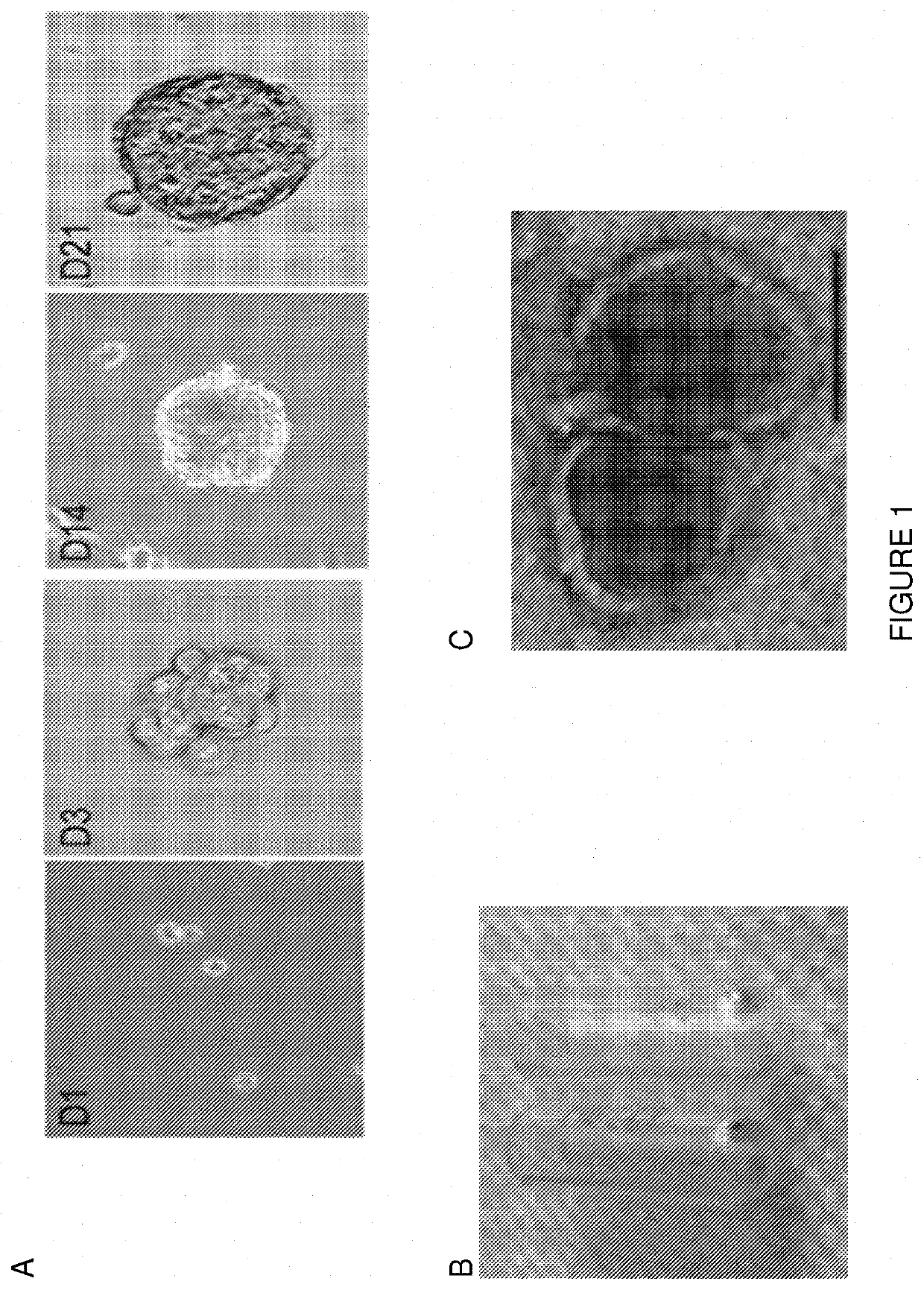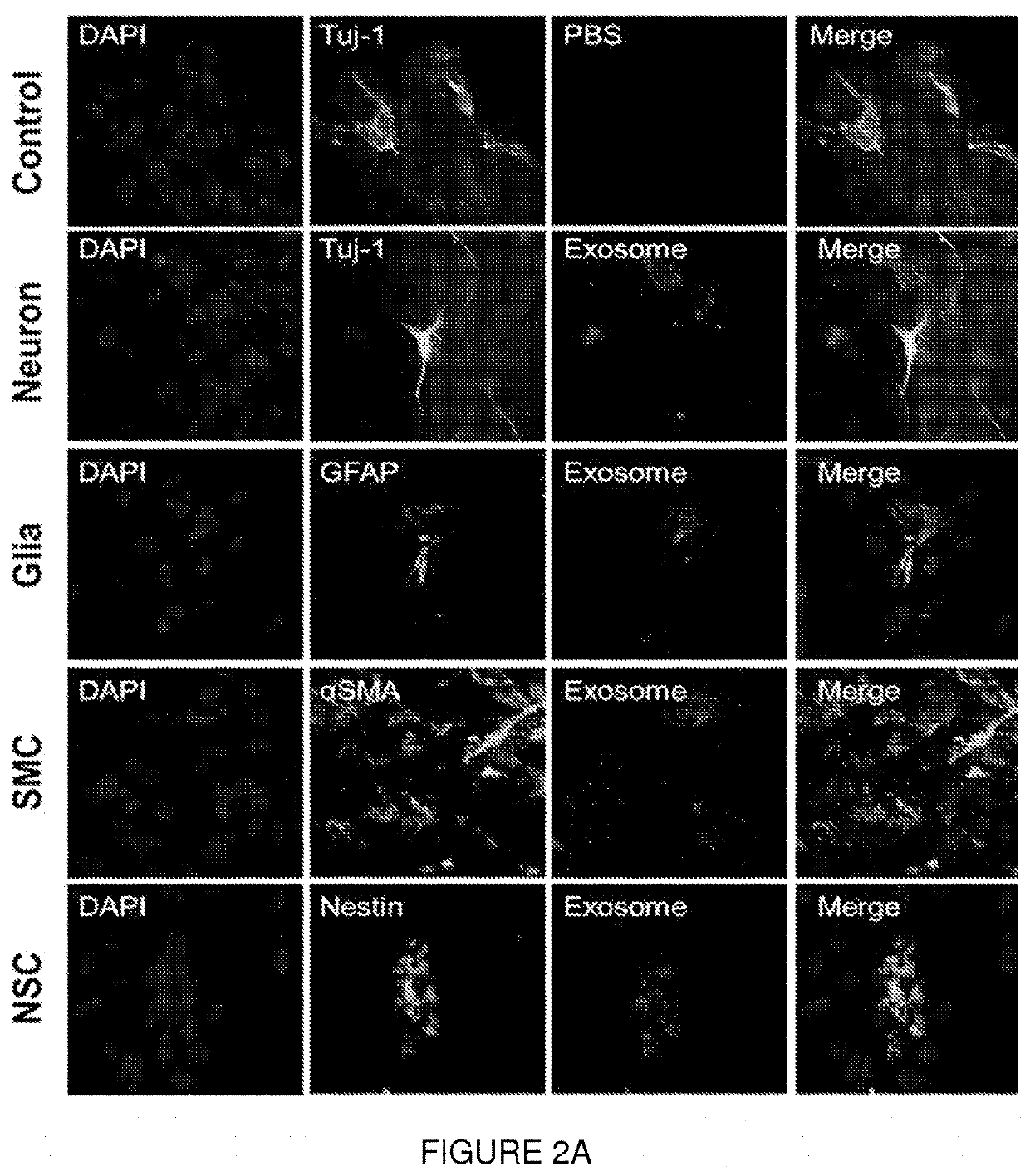Methods of delivering heparin binding epidermal growth factor using stem cell generated exosomes
a technology of epidermal growth factor and stem cell, applied in the direction of unknown materials, drug compositions, peptide/protein ingredients, etc., can solve the problems of intestinal mucosa extremely susceptible to i/r, initiate local and remote tissue damage, and i/r is as lethal as extensive heart and brain ischemia, etc., to achieve rapid epithelial cell migration, restore barrier function, and prevent systemic toxic complications
- Summary
- Abstract
- Description
- Claims
- Application Information
AI Technical Summary
Benefits of technology
Problems solved by technology
Method used
Image
Examples
example 1
Isolation and Characterization of NSC-Derived Exosomes
[0144]Enteric NSCs were isolated from mid gestational guts of embryonic mice. The harvested cells were immunoselected using magnetic beads conjugated with anti-P75 antibody and cultured in NSC medium. Neurosphere-like bodies were allowed to form and were then passed repeatedly. NSC cultured condition medium were collected and spin down to remove debris.
[0145]Initially, NSC-derived exosomes were purified from neurosphere conditioned medium (CM) using the PureExo Exosome Isolation kit (101Bio) according to the manufacturer's instructions. Exosomes were then stained with the red fluorescent cell link dye PKH 26 (Sigma) and characterized for size, size distribution, charge, and morphology using dynamic light scattering, zeta potential analysis, and transmission electron microscopy. Electron microscopy (EM) confirmed the presence of 50-150 nm diameter bi-membrane vesicles. Zeta potential analysis revealed a high negative charge of −24...
example 2
NSC-Derived Exosomes Target Enteric NSC and Injured Neurons
[0146]The anoxia / reoxgenation cell injured model (Watkins et al., J Surg Res 2012; 177:359-64) was used to demonstrate that the NSC-derived exosomes target enteric NSC and localized to injured neurons. Briefly, intestinal LMMP strips were dissected out from P3-P5 rat pups and were treated with enzymatic digestion to obtain mixed cells which includes: myenteric neurons, glial cell, neural stem cells (NSC), smooth muscular cells. Mixed cells were cultured in DMEM / F12: NeuroBasal medium (v / v=1:1) supplemental with 1×B27 and 10% FBS (Gibco) for 10 days. PKH26 labeled NSC derived exosomes were added to the culture medium of the mixed cells and the targeted cells with exosomes were visualized 24 hours later under fluorescent microcopy. In addition, NSC-derived exosomes were applied to the cultured cells 30 minutes prior to the exposure of the mixed cells to 24 h / 24 h anoxia / reoxygenation injury (anoxia chamber was filled with 95% ...
example 3
Neonatal Rat Model of Experimental Necrotizing Enterocolitis
[0148]The studies described herein utilize a neonatal rat model of experimental NEC. These experimental protocols were performed according to the guidelines for the ethical treatment of experimental animals and approved by the Institutional Animal Care and Use Committee of Nationwide Children's Hospital (#04203AR). Necrotizing enterocolitis was induced using a modification of the neonatal rat model of NEC initially described by Barlow et al. (J Pediatr Surg 9:587-95, 1974). Pregnant time-dated Sprague-Dawley rats (Harlan Sprague-Dawley, Indianapolis, Ind.) were delivered by C-section under CO2 anesthesia on day 21.5 of gestation. Newborn rats were placed in a neonatal incubator for temperature control. Neonatal rats were fed via gavage with a formula containing 15 g Similac 60 / 40 (Ross Pediatrics, Columbus, Ohio) in 75 mL Esbilac (Pet-Ag, New Hampshire, Ill.), a diet that provided 836.8 kJ / kg per day. Feeds were started at ...
PUM
| Property | Measurement | Unit |
|---|---|---|
| diameter | aaaaa | aaaaa |
| diameter | aaaaa | aaaaa |
| birth weight | aaaaa | aaaaa |
Abstract
Description
Claims
Application Information
 Login to View More
Login to View More - R&D
- Intellectual Property
- Life Sciences
- Materials
- Tech Scout
- Unparalleled Data Quality
- Higher Quality Content
- 60% Fewer Hallucinations
Browse by: Latest US Patents, China's latest patents, Technical Efficacy Thesaurus, Application Domain, Technology Topic, Popular Technical Reports.
© 2025 PatSnap. All rights reserved.Legal|Privacy policy|Modern Slavery Act Transparency Statement|Sitemap|About US| Contact US: help@patsnap.com



